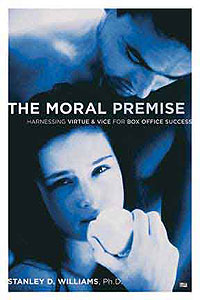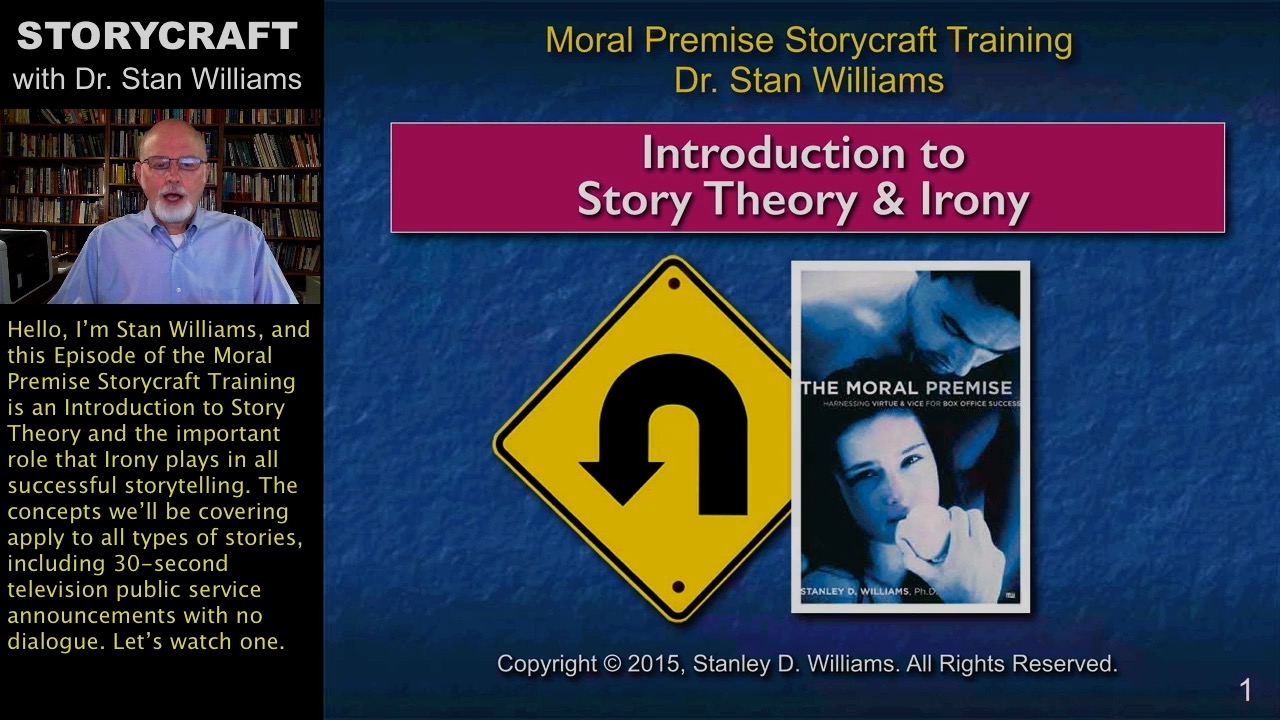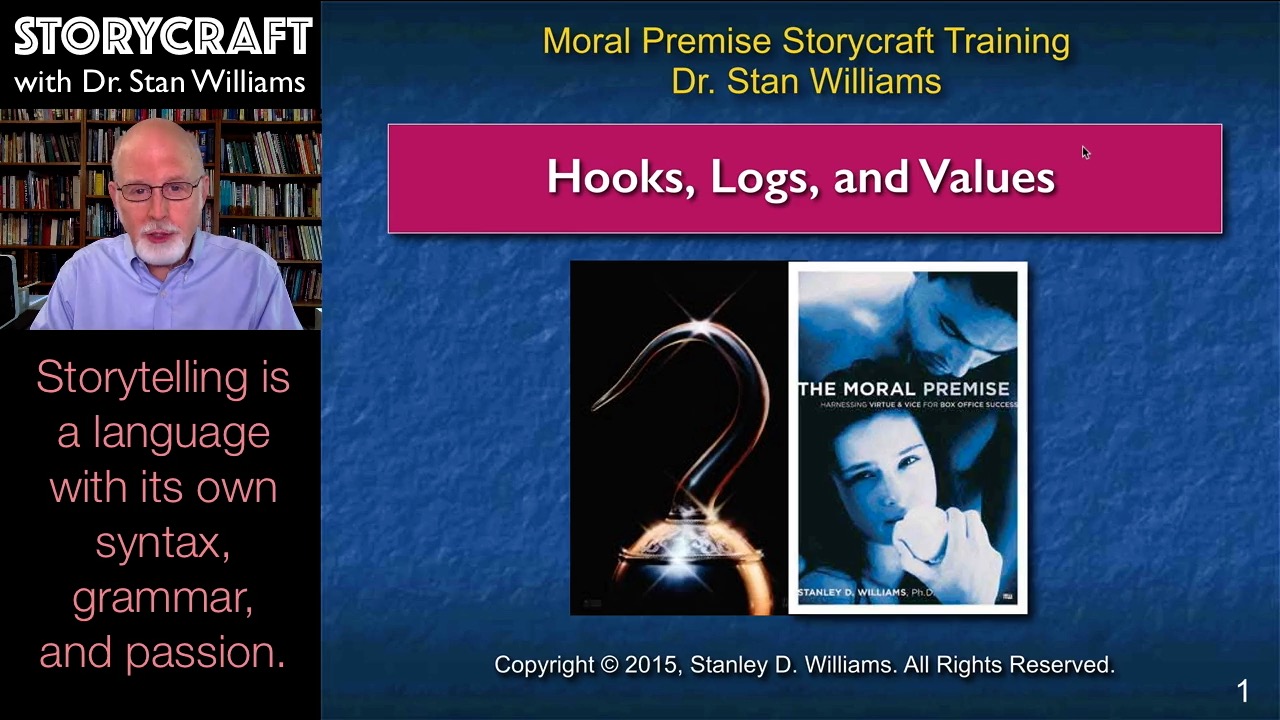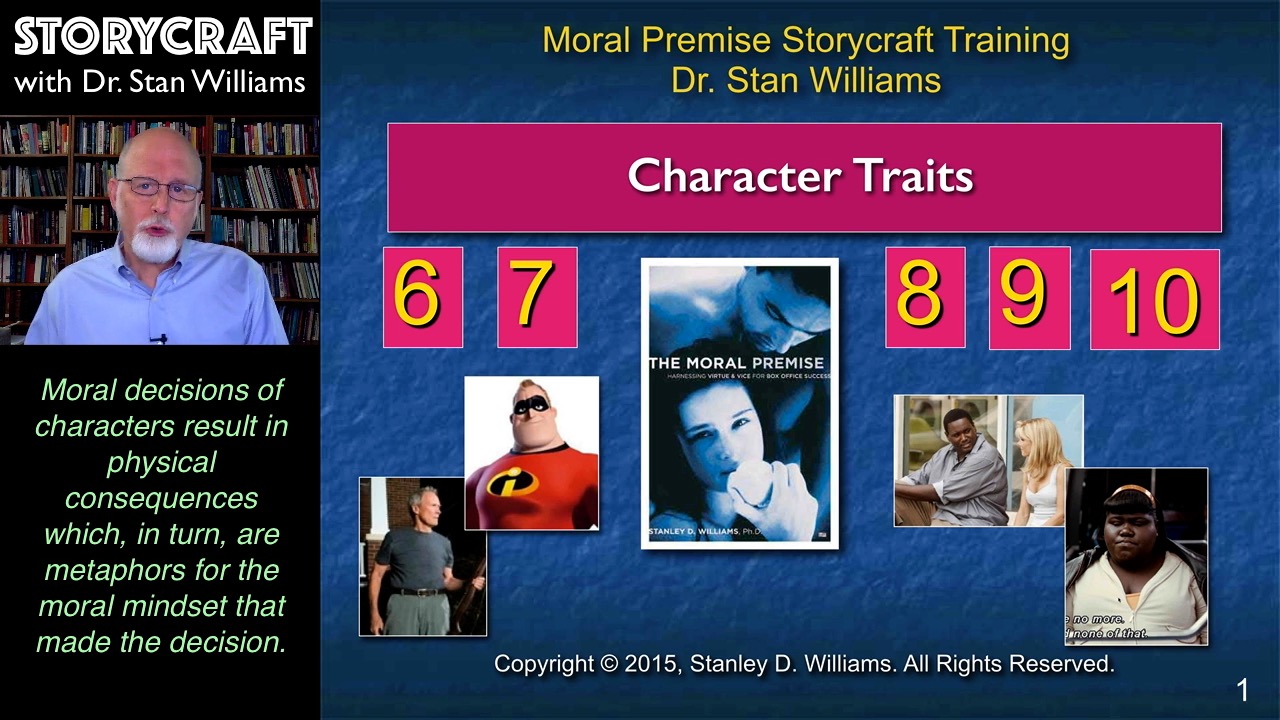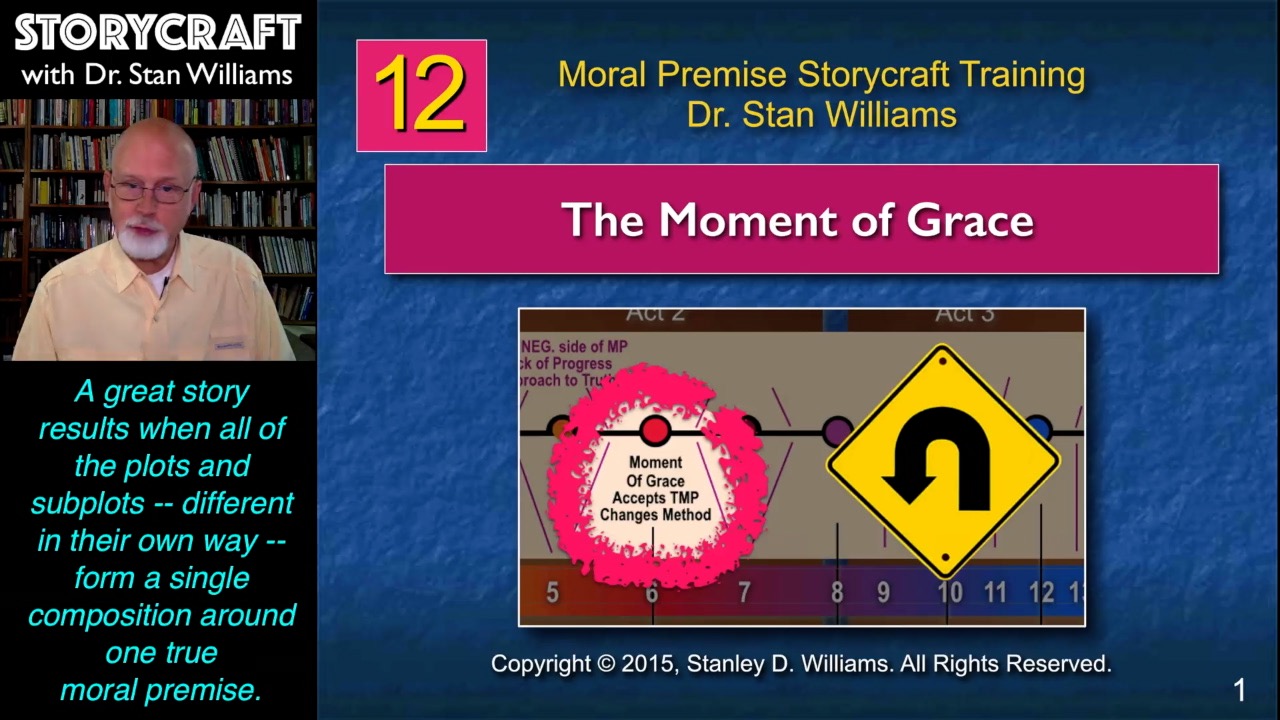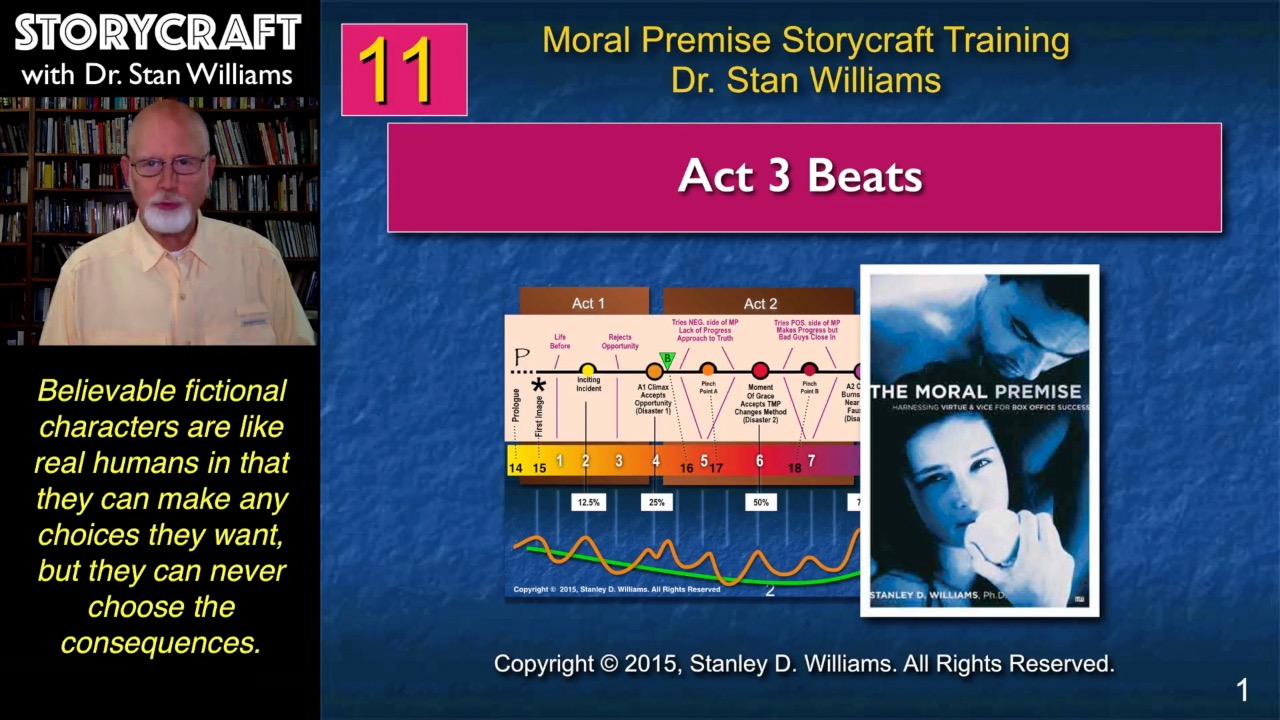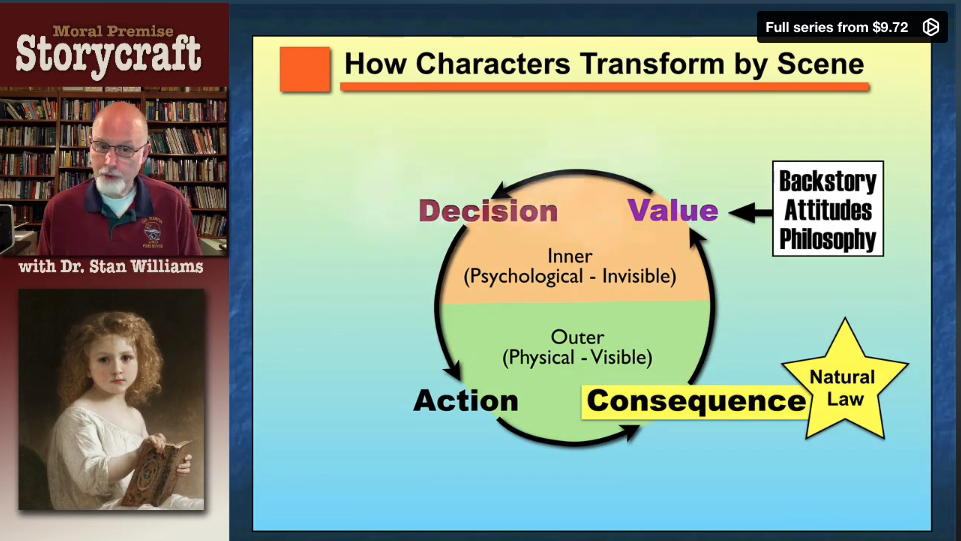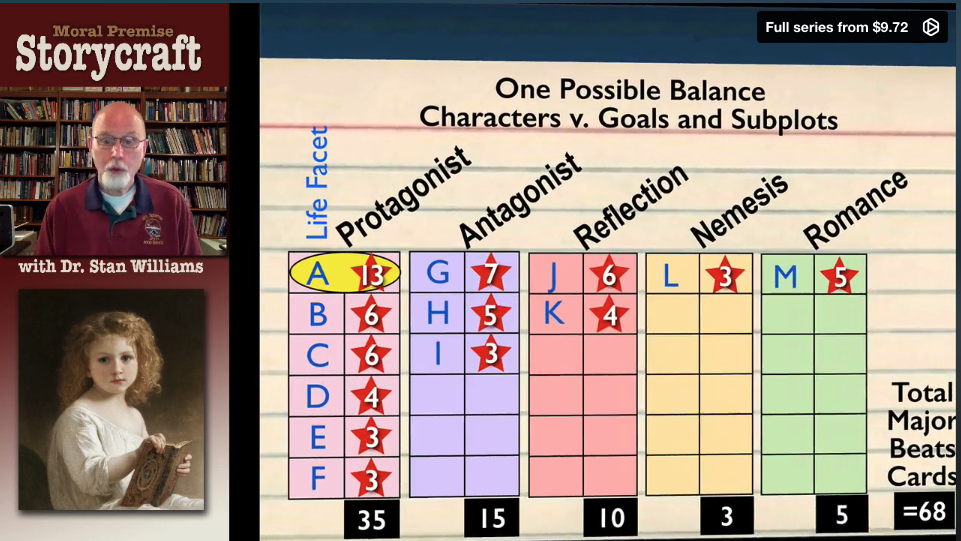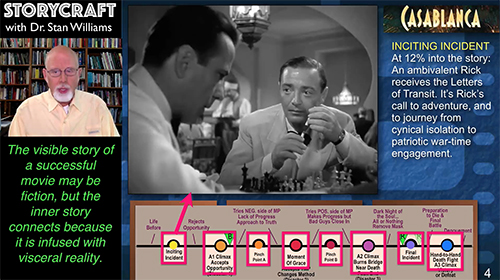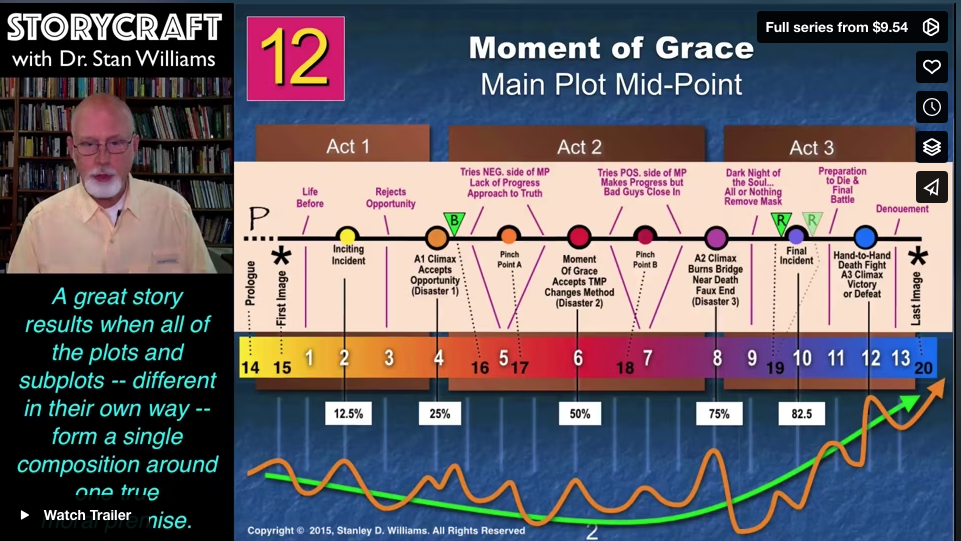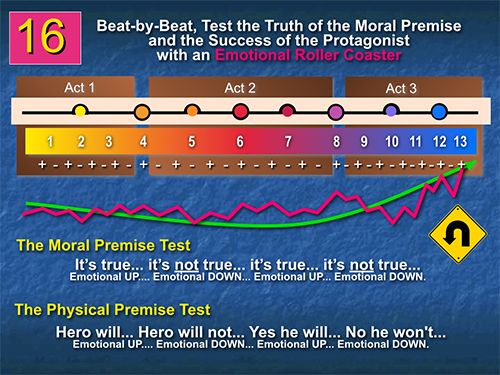|
LESSON LINKS with DETAILS
Lesson 1. Intro Story Theory and Irony
Lesson 1 contains 2 parts: Episode 1 (Video 1A) and Episode 2 (Video 1B)
This 32-minute, 2-part lesson reviews three basic concepts behind all successful stories. Part 1 covers: (A) The place of Story in Culture and why the telling of stories is so important; and (B) the importance of a story's Moral Premise that effects sales, character transformation, inner and outer spines, motivation & action, and cause & effect. Part 2 covers (C) Aristotle's Six Pillars of a Great Story and how they relate to irony, conflict, suspense and tension.
SPECIFICALLY, THIS LESSON COVERS:
- Why storytelling is the crux of culture
- What stories teach you that nothing else can
- How fictional stories tell the truth
- The interrelationship between the two spines of ever story
- The role of Natural Law in story creation
- How the inner and outer journeys can be summarized in one sentence
- The correlation between a story's moral validity and box office receipts
- The three transformations in every story
- How the inner and outer stories can be unified
- How inter values motivate outer action
- How drama and intrigue originate from what is natural
- The role irony plays in every aspect of a successful story
- How Aristotle's 6 pillars of a great story contribute to drama and suspense
- Why impossibilities are necessary in every story
- What Ratatouille, The Kings Speech, Gravity, and Django have in common
Lesson 2. Hooks, Log Lines & Values
Lesson 2 contains 3 parts: Episode 3 (Video2A), Episode 4 (Video 2B), and Episode 5 (Video 2C)
This 53-minute, 3-part lesson explains the first three secrets of all successful stories, and three of the Moral Premises' Story Fundamentals: Ironic Hooks, Log lines, and the motivational Conflict of Values. These are critical to the success of all stories if they are to connect with audiences. Getting these three secrets and fundamentals right will speed your writing and help ensure your audience connects emotionally with your characters. Prerequisite Recommendation: Lesson 1.
SPECIFICALLY, THIS LESSON COVERS:
- The first three secrets of successful stories
- The six Story Fundamentals you need to know before you begin to write
- The four elements of a ironic hook
- The five critical ingredients of a Log Line
- The alternative four questions every log line needs to answer
- The four word outline of every successful tory's structure
- The five elements of a motivating conflict of values
- How to incorporate linguistic ironic conflict in sentence structure
- The structural difference between redemptive and tragic stories
Lesson 3. The Moral Premise Statement (Rumble)
Lesson 3 contains Episode 6 (Video 3A) and Episode 7 (Video 3B).
This 35 minute, 2-part lesson explains the organic basis of the Moral Premise Statement, how it is constructed, how it is used, and how it focuses all the creative elements in a movie, novel or play so all the plots and subplots are about one thing. We also show clips from two films as examples. Prerequisite Recommendation: Lessons 1-2.
SPECIFICALLY, THIS LESSON COVERS:
- Verisimilitude: The integration of 3 critical elements of all successful stories: (1) ironic characters, (2) an impossibility hook, and (3) value based psychological motivations of the characters.
- Relationship between the two story realities: The Psychological and Physical worlds.
- How moral values and decisions precipitate actions.
- How actions result in physical consequences
- How physical consequences inform moral value
- The theoretical and practical structure of the Moral Premise statement
- How the Moral Premise Statement is often articulated in movies
- How the Moral Premise Statement keeps the story focused on one thing.
- How the Moral Premise Statement provides support for character arcs.
- Capstone example and clips from Die Hard
- The fifth secret of successful story telling: Consistent Application of the Moral Premise
Lesson 4. Character Traits (Secrets)
Lesson 4 contains Episode 8 (Video 4).
This 24 minute, one-part lesson teaches you five critical traits that your protagonist (and all other main characters) must have in order to emotionally connect with audiences. These include Imperfection, Passion, Visible Goals, Psychological Needs, and the origin of organic insurmountable physical obstacles that prevent the protagonist and others from reaching their goals. Prerequisite Recommendation: Lessons 1-3.
SPECIFICALLY, THIS LESSON COVERS:
- Successful story secrets six through 10
- Why your protagonist needs to be imperfect
- How your protagonist must strive to change
- The importance of a protagonist's visible physical goal
- The motivation of the protagonist's psychological need
- How the protagonist's psychological need creates physical obstacles.
Lesson 5. Evolution of Story Structure
Lesson 5 contains Episode 9 (Video 5A) and Episode 10 (Video 5B).
This 42 minute, 2-part lesson uses 46 slides and 1 clip to explains the development of story structure in order to create an emotional roller coaster ride for your audience or reader. The lesson focuses on the traditional 3-act, 13-beats of successful stories, but also describes alternative beats that are based on the human condition and result in act structures of 5, 7 and 12. Prerequisite Recommendation: Lessons 1-4.
SPECIFICALLY, THIS LESSON COVERS:
- Secrets to Successful Stories 11 & 16
- How story structure evolved
- The critical dramatic beats of a 30-second story
- How the placement and character of beats are determined
- The three disasters of a novel
- The three parts of all stories
- The 13 traditional macro beats of a successful motion picture or novel
- How to solve a "slow middle"
- How the 13 macro beats and Pinch Points create a perfect roller coaster
- The psychological and physical roller coaster of a story
- How to create a roller coaster with a spread sheet
- Five alternative story structures
Lesson 6. Act 1 Beats (Rumble)
Lesson 6 contains Episode 11 (Video 6A).
This 21 minute, one-part lesson explains and provides examples for the critical story beats found in Act 1: First/Last Image, Life Before, The Inciting Incident, Rejecting the Journey, Act 1 Climax, and Crossing the Threshold. Examples are provided through 20 graphic slides, and clips from four movie clips. Prerequisite Recommendation: Lessons 1-5.
SPECIFICALLY, THIS LESSON COVERS:
- How story structure is part of Natural Law of Life's Structure
- The importance (with examples) of the First and Last Image
- Why visual storytelling is important, even in novels.
- Two examples of the Inciting Incident and why it's important
- The Act 1 Climax beat from Ratatouille's co-protagonists.
- Crossing the Threshold Beat in Harry Potter's Sorcerer's Stone
Lesson 7. Act 2 Beats
Lesson 7 contains Episode 12 (Video 7A), Episode 13 (Video 7B), and Episode 14 (Video 7C)
This 59-minute, 3-part lesson explains Act 2 beats and provides example from two motion pictures. A special feature of Parts 2 & 3 is the macro breakdown, with example clips, of CASABLANCA's 8 major turning point and pinch point beats. Prerequisite Recommendation: Episodes 1-6.
SPECIFICALLY, THIS LESSON COVERS:
- Secrets to Successful Stories 11, 13 and 16
- Turning Point Beats vs. Sequence Beats
- Act 1 Climax and Act 2 B-story start beats
- Act 1-2 and Act 2-3 transitions in The Lord of the Rings: Fellowship....
- The Eight major turning point beats in Casablanca
- The Mid-Act 2 Beats in Casablanca
- Beat contribution to the story's emotional Roller Coaster
- The difference between Protagonist and Antagonist beats
- Act 2 Climax and Act 3 transition in The Lord of the Rings: Fellowship...
Lesson 8. Moment of Grace (The Midpoint)
Lesson 8 contains Episode 15 (Video 8A) and Episode 16 (Video 8B)
This 53-minute, 2-part lesson explains and shows examples of the The Moment of Grace (MOG) in successful and not so successful motion pictures. The MOG is the main plot's mid-point. It's the scene where the truth of the Moral Premise is realized by the Protagonist and he or she changes their motivations, and thus changes their arc. Examples are shown from Lord of the Rings, A Beautiful Mind, Liar! Liar!,What Women Want, Ratatouille, and Aronofsky' Noah. Prerequisite Recommendation: Lessons 1-7.
SPECIFICALLY, THIS LESSON COVERS:
- The 12 and 13th Secrets of Successful Stories
- How the Moment of Grace defines all plot arcs
- Why the protagonist's Moment of Grace is at the mid-point
- How other Moments of Grace can be just about anywhere.
- Examples of the Moment of Grace in A Beautiful Mind, Liar! Liar!, Ratatouille, What Women Want, Lord of the Rings: Fellowship and Noah.
- Compares and contrasts the two Moments of Grace in Noah.
Lesson 9. Act 3 Beats (Rumble)
Lesson 9 contains Episode 17 (Video 9).
This 28-min, one-part lesson explains and shows examples of the major beats in Act 3: The Dark Night of the Soul, The Resurrection Beat, The Final Incident, The Act 3 Climax and Final Hand-to-hand combat, and the Denouement. It features clips from Lord of the Rings: Fellowship of the Ring, Die Hard, and Where the Heart Is. Prerequisite Recommendation: Lessons 1-8.
SPECIFICALLY, THIS LESSON COVERS:
- The major protagonist beats in Act 3 listed above
- The Dark Night of the Soul from Lord of the Rings: Fellowship...
- The Resurrection Beat from Die Hard
- When and when not to place a Moment of Grace in Act 3
- How Act 3 can hold the secret to a character's Wish Fulfillment
- The Final Incident from Where the Heart is
- The Hand-to-hand combat and Act 3 Climax in Where the Heart Is
- The Denouement from Where the Heart Is
Lesson 10. Transformation, Goals & Plots
Lesson 10 contains Episode 18 (Video 10A), Episode 19 (Video 10B), and Episode 20 (Video 10C)
This 54-minute, 3-part lesson, covers the foolproof, anti-writers-block method for screenwriters, novelists, and playwrights for designing their character's transformation. It describes the theory and a method for the proper construction of plots, subplots, goals, subgoals, and irony. It is based on the Moral Premise concept of vice, virtue and their natural consequences. The workshop contains 54 colorful slides that offer extended material which is based on the Hollywood story structure book: The Moral Premise: Harnessing Virtue and Vice for Box Office Success. Prerequisite Recommendation: Lessons 1-9.
SPECIFICALLY, THIS LESSON COVERS:
- Review of the traditional beats and the rollercoaster effect
- How the major beats are laid out on a story diamond.
- How Characters transform through the Values-Actions cycle
- How Inner Values motivate Outer Action
- How the protagonist has no control over the consequences of his/her action
- Why each subplot must have an associated goal
- Why characters have multiple subplots
- How subplots are created from a character's life aspects
- How the Moral Premise unites plots and subplots
- How to card a plot or subplot
- How to determine who the protagonist of a story is and how to keep him or her in that role
- How Irony dramatizes Goals and Plots
- How Irony naturally leads to Oscar winning scripts
Lesson 11. Visualizing Story Structure
Lesson 11 contains Episode 21 (Video 11A), Episode 22 (Video 11B), and Episode 23 (Video 11C)
This 57-minute, 3-part lesson examines four useful diagrammatic methods for visualizing and breaking down traditional story structure. The first video summarizes and reviews the 13 basic beats and 7 accent beats of the linear major beat structure discussed in greater detail in Lessons 5-9. An important feature of this breakdown is the regular emotional roller-coaster effect these beats provide. Taking those 20 beats, the second video breaks down the Moral Premise Story Diamond and explains one-by-one nine (9) different story structure models, layering each side-by-side to reveal how each model provides a fresh perspective of the same Natural Law of Story Structure. The models explained come from Stan Williams-Michael Hauge, Chris Vogler-Joseph Campbell, Michael Arndt, Blake Snyder, Jeffery Schechter, Bernard Brock, Küber-Ross, Allison Fisher, and Joseph Gulino. The resulting Story Diamond Key (a free download from MoralPremise.com), provides writers a one-sheet story-breaking aid that minimizes writer's block. The third video takes the same fundamental 20 story beats and applies them to a third graphic metaphor for breaking a story—the Eight Mini Movie Beat Sheet. Based on Gulino's Sequence method and the Williams-Hauge model, this video shows how each mini movie should end in a disaster. Lastly, at the end of the third video there is a brief look at the progress Final Draft 12 is making with their Beat Board, Outliner, and Script Insertion function that dramatically smooths the process from beating out a story graphically and inserting the outline and cards directly and quickly into Final Draft script pages.
Lesson 12. Writing Convincing Movie Dialogue (Rumble)
Lesson 12 contains Episode 24 (Video 12A) and Episode 25 (Video 12B)
This 63-minute, 2-part lesson provides 20 Tips (or Techniques) for writing convincing movie dialogue. The first video provides 10 Tips of What to Do, and the second video provides 10 Tips of What NOT to Do. Thirteen clips from popular motion pictures and TV programs are provided including: Social Network, TV's Seinfeld, The Great Gatsby, Meyerowitz Stories, Chinatown, Raiders of the Lost Ark, The Graduate, Family Man, TV's Taxi, What Women Want, Casablanca, and As Good As It Gets.
|

